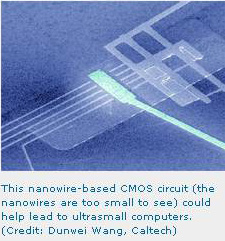Computer with Nanowires
 Silicon nanowires, because of their small size and excellent electronic properties, could enable ultrasensitive handheld sensors for detecting cancer or identifying biological hazards. These nanowires could also lead to more powerful, energy-efficient computer chips. But until now, prototypes of nanowire-based circuits were made using techniques that are not suitable for batch processing.
Silicon nanowires, because of their small size and excellent electronic properties, could enable ultrasensitive handheld sensors for detecting cancer or identifying biological hazards. These nanowires could also lead to more powerful, energy-efficient computer chips. But until now, prototypes of nanowire-based circuits were made using techniques that are not suitable for batch processing.Now, researchers at Caltech have made silicon-nanowire-based logic circuits similar to the complementary metal-oxide semiconductor (CMOS) circuits used in computer chips. To make p- and n-type transistors (the two types needed in CMOS circuits), scientists first created a checkerboard pattern of the p- and n-type silicon. They doped adjacent squares with different dopants, using photolithography-produced masks. Then, they selectively etched away silicon to form orderly arrays of nanowires using a special technique developed earlier. Finally, they connected these nanowires using e-beam lithography to form transistors and a fundamental type of logic circuit called an inverter.
Because the new method can produce both types of transistors on a single surface, it could be suitable for mass production. The new methods could finally make nanowire circuits practical to manufacture.
Reference: Dunwei Wang, Bonnie Sheriff, and James R. Heath, “Complementary Symmetry Silicon Nanowire Logic: Power-Efficient Inverters with Gain,” Small (cover article) 2(10), 1153-1158 (2006). Link to Article.
Labels: Nanotechnology


0 Comments:
Post a Comment
<< Home